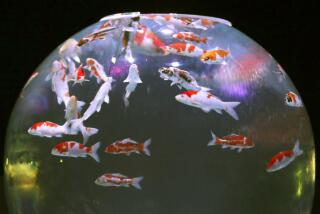View From Japan : Investors See a Good Deal : There was a 250% annual rise in businesses’ financial stake in China last year. But a history of boom and bust has some in Tokyo urging caution.
- Share via
TOKYO — When Shunichiro Aoki first moved to Beijing in 1979 to represent Matsushita Electric Industrial Co., he ran a one-man operation out of his home. Now he is in charge of a sprawling television picture tube factory near Beijing with 2,000 employees. The consumer electronics giant recently announced plans to build new factories to manufacture air conditioners and compressors as well as sophisticated VCR components.
“By the year 2000, our Chinese operations will be about the size of our American and European operations,” says Aoki confidently.
A year ago, Aoki’s skeptical Japanese colleagues would have dismissed him as a dreamer. But now, hardly a day goes by without news of another Japanese factory going up in China.
After years of standing on the sidelines, Japan is investing in China on a scale unmatched since the 1930s when the Japanese invaded Manchuria and made it the industrial heartland of their Asian empire.
Last year, Japanese companies signed 2,000 investment deals in China worth $2.1 billion, up 250% from the year before. The companies hope to take advantage of China’s low-cost labor to counter a soaring yen that threatens to make Japanese exports uncompetitive. And they are eagerly eyeing China’s booming domestic market.
“There are 270 million households (in China) and the average savings account holds (the equivalent of) 100,000 yen ($940),” says Aoki. “Chinese families can afford to buy a lot of consumer products now.”
Not all Japanese are as bullish as Aoki. Japanese companies have experienced so many boom and bust periods in China that “there isn’t a lot of trust,” says Kenji Hattori, chief manager of planning and coordination at the Japan-China Assn. on Economy & Trade.
Japanese Emperor Akihito took a major step toward building that trust last fall when he traveled to China and expressed “deep sadness” over the suffering Japan inflicted during its invasion and occupation of China.
“The emperor’s visit opened a new epoch,” says Hattori. “We can look to the future without being tied down by the past,” he says. “China is no longer trying to (exploit the past) to force concessions from Japan.”
A sign of Japan’s confidence in the strength of the relationship was its recent decision to slap dumping charges against the import from China of silico-manganese, a product used in steel production. “We don’t have to feel restrained anymore,” says Hattori. “We can be frank and honest.”
*
Japanese investors say China’s effort to become a part of the General Agreement on Tariffs and Trade (GATT) is another reassuring sign that the nation means to move ahead with economic reform.
China has become an attractive place to invest just as a rising yen is forcing a growing number of Japanese manufacturers to consider offshore production. Although Southeast Asia has been the primary recipient of Japanese investment in the past, rapidly rising wages in countries like Thailand and Malaysia have made China a more attractive choice.
“Japan’s export industries are becoming uncompetitive, and they have to cut production costs to break even,” says Nobuo Maruyama, director of the Economic Cooperation Department of the Institute of Developing Economies, a quasi-governmental think tank.
So far, Japanese investments have been on a relatively small scale. Last year, Japan ranked only fourth among foreign investors in China after the United States, Taiwan and Hong Kong.
Japanese companies say history has influenced them to move cautiously. In the late 1970s, China ordered $3.5 billion worth of steel and chemical plants from Japan only to discover halfway through delivery that it couldn’t make the payments. In 1985, Japanese exports to China rose to a peak only to plunge when China closed the import spigot. In 1989, the Tian An Men crackdown on pro-democracy protesters doused another China boom.
Japanese executives say they don’t think China will turn against them this time, but they aren’t taking any chances.
For example, Sumitomo Corp., a large trading company, has made several minor investments in China, including a factory to supply steel tubes for bicycle factories in southern China. But as it considers bigger investments, it plans to find partners. It may soon join with five other Japanese trading companies to invest nearly $5 billion in a giant petrochemical complex in the south of China. But where possible, the company wants American or European partners.
Yutaka Sugihara, Sumitomo’s general manager of China affairs, says the Chinese government is less likely to take action that would harm a project if a major American company is involved.
But Japan cannot be too cautious. With the economies of Europe and America stagnant, China’s high-growth economy emerged last year as a critical export market for Japan. Japan’s exports to China in 1992 totaled $12 billion, double their level in 1990.
*
Particularly strong were exports in areas like steel, machinery, electronics and chemicals, all of which have been depressed in Japan.
And Japan has been pleasantly surprised by China’s ravenous appetite for high-end Japanese consumer products. Last year, Sharp Corp. introduced its video projector for use with laser-disc karaoke (sing-along) systems in China. Although the units were priced at $2,400 apiece, the company nevertheless sold 10,000 in the first year.
Big televisions and refrigerators are also in demand. “There are 50 refrigerator factories in China, but there are a lot of rich Chinese who want the bigger, high-tech refrigerators,” says Michihisa Kitashirakawa, head of China affairs for Toshiba Corp.
Japanese lingerie maker Wacoal sold 300,000 bras last year, even though its products (at $5 apiece) carry price tags five times higher than those of the competition and represent 10% of the average monthly salary of the Chinese worker. Japanese retailers are also moving to tap into that economic boom. Yaohan, which moved its headquarters to Hong Kong in 1990 so it could have better access to the Chinese market, plans to build 1,000 stores across China by 2010, for example.
A Yaohan spokesman compares China today to Japan in the early 1960s at the beginning of its economic takeoff. The stores have become so well known that one popular song in China has a line about what “Yaohan fashions” there will be in 1997 when Hong Kong reverts to China.
Even ritzy department store chains like Seibu and Isetan have plans for stores in China’s major cities. And a cosmetic wholesaler plans to open a chain of 20 beauty salons over the next three years.
The Japanese owner of a Korean barbecue chain who is setting up branches in China says it takes him six years to get a return on a new Japanese store. In China, he says, a new restaurant pays for itself in a year.
The drive of Japanese businesses into China is reinforced by government aid. In the past decade, Tokyo has provided nearly $30 billion in low-interest loans, accounting for as much as a third of China’s foreign aid loans. The money was used to buy equipment from Japan for use in road, rail and other infrastructure projects.
The public money continues to flow. Japan’s latest plan calls for about $7.5 billion in yen credits from 1991 to 1995.
As the China boom begins to take off in Japan, consulting companies to advise on investments in China are sprouting up like mushrooms after a rainstorm. A sample of the advice they are doling out to their eager customers: The risks are high, but the returns could be phenomenal.
More to Read
Inside the business of entertainment
The Wide Shot brings you news, analysis and insights on everything from streaming wars to production — and what it all means for the future.
You may occasionally receive promotional content from the Los Angeles Times.










